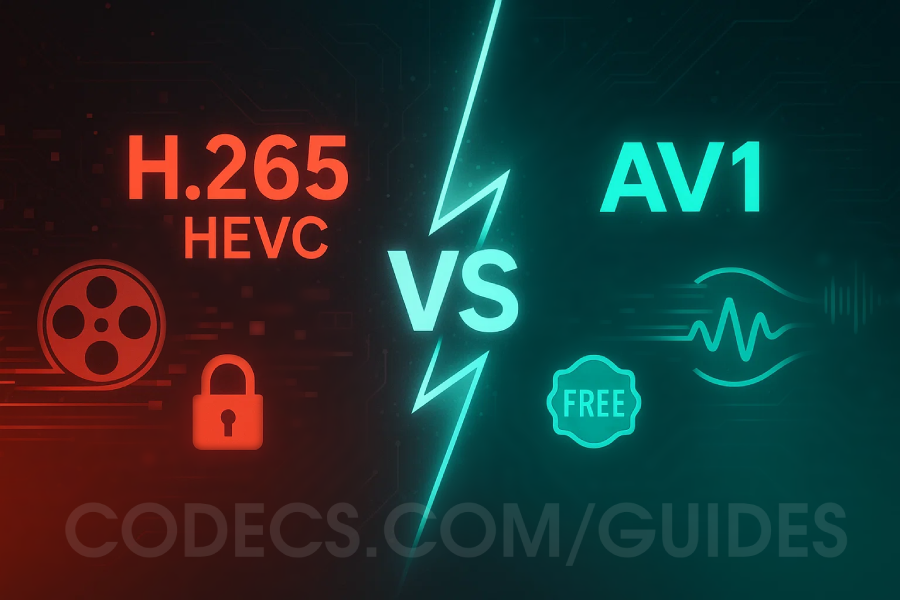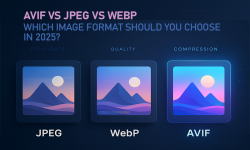If you've been researching video codecs for streaming, content creation, or just wondering what those terms mean in your video player settings, you've probably seen two names come up repeatedly: AV1 and H.265 (also called HEVC).
Both promise great video quality with smaller file sizes, but which one should you actually use?
The short answer is: it depends on what you're doing with your videos and who's watching them.
Let's break this down in plain English so you can make the right choice.
What Are These Codecs Anyway?
Think of video codecs as different languages for compressing video files. They take massive raw video files and shrink them down so they're easier to store and stream online without losing too much quality.
H.265 (HEVC) has been around since 2013 and is what most devices use today.
Your smart TV, phone, and streaming apps probably all support it. It's like the reliable standard that everyone knows and trusts.
AV1 is the newer option, backed by big tech companies like Google, Netflix, and Apple.
It's designed to squeeze video files even smaller than H.265 while keeping the same quality. The best part? It's completely free to use, with no licensing fees.
The Big Difference: File Size and Bandwidth
Here's where AV1 really stands out. It can compress videos 20-30% smaller than H.265 while keeping the same quality.
In practical terms, if you have a 4K movie that's 10GB in H.265, it would be around 7-8GB in AV1.
Why does this matter to you? Smaller files mean:
- Faster uploads and downloads.
- Less data usage on your phone or internet plan.
- Cheaper storage costs if you're hosting videos.
- Smoother streaming on slower internet connections.
H.265 is still pretty efficient - it's about 50% smaller than the older H.264 codec most people used before.
So it's not bad by any means, just not quite as space-saving as AV1.
Video Quality: What Will It Look Like?
Both codecs deliver excellent video quality, but they each have their sweet spots.
AV1 performs better when internet speed is limited.
If you're streaming on a slower connection or watching on mobile data, AV1 maintains better quality at those lower speeds. It's particularly good for 4K and HDR content where you want crisp details even when bandwidth is tight.
H.265 shines when you have plenty of bandwidth.
For things like Blu-ray discs or high-quality broadcasts where file size isn't the main concern, H.265 delivers stunning results that match AV1. It supports up to 8K resolution and is used for premium physical media.
Bottom line: Both look great, but AV1 is better for streaming and H.265 is proven for physical media.
Will Your Devices Support It?
This is probably the most important consideration for the average person.
H.265 works on almost everything. If your device was made after 2015, it almost certainly supports H.265. Your TV, phone, tablet, computer, streaming stick—they all handle it without any issues. This universal support is H.265's biggest strength.
AV1 is growing but not everywhere yet. Modern web browsers (Chrome, Firefox, Edge, Safari) support AV1, which is why YouTube and Netflix have started using it.
Newer phones and computers from 2022 onward can play it smoothly. But older TVs, streaming devices, and phones might not support it at all.
If you're creating content and want everyone to be able to watch it, H.265 is the safer bet right now.
If you're targeting viewers with newer devices or streaming on the web, AV1 works great.
Processing Time: How Long Does Encoding Take?
Here's where things get tricky for content creators. AV1 takes much longer to process - we're talking 5-10 times longer than H.265. If you're uploading videos regularly or need quick turnarounds, this can be frustrating.
H.265 encodes much faster, which is why it's still preferred for live streaming, video calls, and situations where you can't wait hours for a video to process.
For most casual users just watching videos, this doesn't matter. But if you're creating content, the encoding time difference is real.
Cost Considerations
AV1 is completely free to use. No licensing fees, no hidden costs. For streaming platforms or content creators working at scale, this can mean significant savings on both licensing and bandwidth costs.
H.265 requires licensing fees if you're building products or apps that use it. For individual users, this usually doesn't affect you directly, but it's one reason why some platforms prefer AV1.
So Which Should You Choose?
Choose AV1 if:
- You're streaming content on the web (YouTube, personal website).
- Your audience has newer devices.
- You want the best compression and don't mind longer processing times.
- You're building something and want to avoid licensing costs.
Choose H.265 if:
- You need maximum compatibility across all devices.
- You're working with live video or need fast processing.
- Your audience includes people with older TVs and devices.
- You're creating content for physical media like Blu-rays.
For most people watching videos: You don't need to choose - your device and the streaming platform handle this automatically.
YouTube, Netflix, and other services will send you AV1 if your device supports it, or fall back to H.265 if it doesn't.
For content creators: Start with H.265 for maximum reach, and consider adding AV1 versions as your audience and tools evolve.
Many platforms now support uploading both formats to give viewers the best experience for their device.
AV1 is the future of video streaming with better compression and no licensing fees, but H.265 is still the present reality with universal device support. Neither is "better" in all situations - it's about matching the codec to your specific needs.














How to Download HEVC Video Extension for Free
actually worked, made my day better icl
Read More →Best Player for Subtitles (2025 Guide)
@P.A. Blok You're right, thanks for the feedback! We've updated the guide to clarify that VLC does auto-detect ...
Read More →How to Play HEVC Files in VLC Media Player (2...
@VanguardLH You're right, it'll be corrected. Thanks for pointing it out!
Read More →